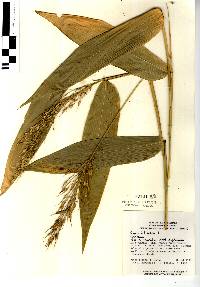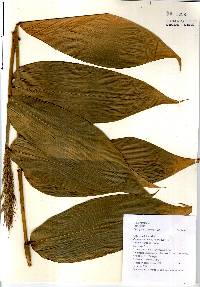
Neotropical Flora
|
Family: Poaceae
[Olyra cordifolia Kunth] |
Monoecious perennial, mostly 2-3 m tall and erect to arching, rarely to 5 m long and clambering; culms becoming woody, to 6 mm diam, often mottled with purple, freely branching at upper nodes. Sheaths glabrous to hispid, usually longer than the internodes, the lowermost short and nearly bladeless; blades lance-linear to lance-oblong, inequilateral, acuminate at apex, acute to rounded at base, very short-petiolate, the lower surface usually glabrous, the margins and midrib on upper surface scabrous, the upper surface papillate or papillate-scabridulous. Panicles terminal or upper-axillary, narrow to pyramidal, 5-17 cm long; branches and peduncles closely scabrid and sparsely hispid, the branches with a single pistillate spikelet at the end, the staminate spikelets scattered along branch below it; staminate spikelet reduced to the awned lemma and palea, deciduous, 4-5 mm long excluding awn, the awn 2-3 mm long; pistillate spikelet lacking first glume; second glume and sterile lemma 1-2 (2.5) cm long, long-acuminate, minutely scabridulous, diverging and exposing fruit at maturity, often purplish along margin. Fruits white, shiny, smooth, indurate, acute at apex, 5-6 mm long. Croat 6634, 11713. Plants are extremely variable, especially in size of leaves and inflorescences. The larger plants, which may represent tetraploid races, have previously been separated as O. cordifolia H.B.K., but the species is now considered polymorphic. |
|
|
|
Powered by Symbiota.

























